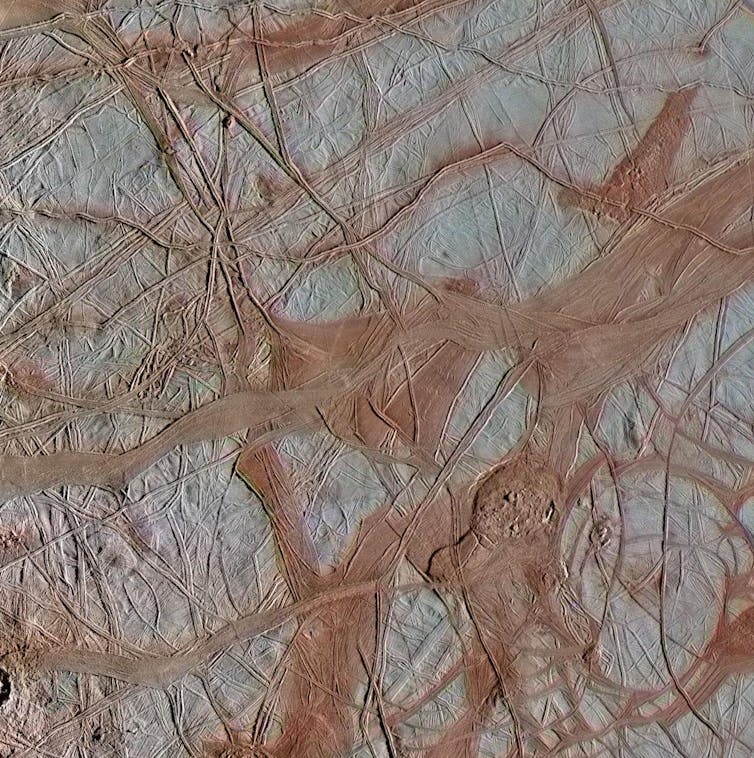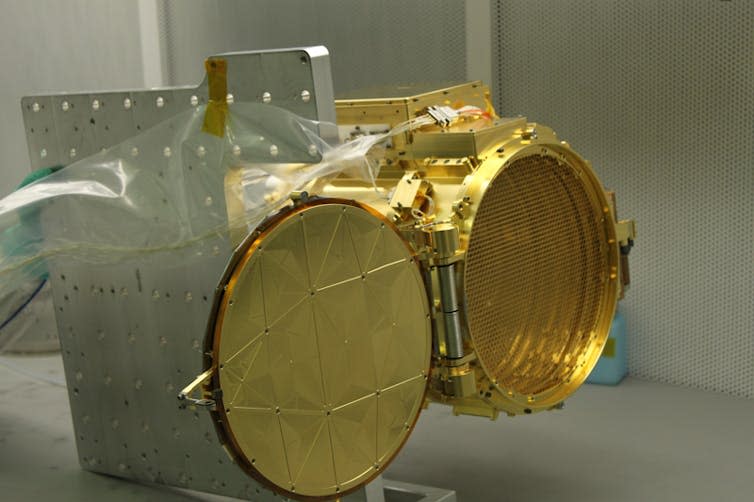Europa is one of the largest of over 90 moons orbiting the planet Jupiter. It is also one of the best places to observe alien life.
Often called an “ocean world” by scientists, observations so far strongly suggest that a liquid brine ocean could exist beneath Europa’s icy crust containing twice as much water as Earth’s oceans. Now, NASA’s Europa Clipper – the largest spacecraft ever developed by the US space agency for a planetary mission – may have the tools to detect it.
As the Clipper spacecraft undergoes final testing and preparations before its launch in October 2024, scientists using one of the nine instruments on board have made an exciting discovery. As well as determining whether Europa could support life, the instrument in question should be able to directly detect alien life itself – if it exists.
The three main ingredients for life are energy, liquid water and the right chemicals. The spacecraft will provide more data on these ingredients at Europa, and therefore its potential for hosting life.
Europa receives energy from the extreme tidal forces caused by Jupiter’s gravity, which push and pull the moon’s material, generating heat within it. It is this process that supports the theory of a subsurface liquid water ocean.
The chemical building blocks for life in the ocean may be extraterrestrial. These include chemical elements such as carbon, oxygen, phosphorus and sulphur. But the mission team will also be on the lookout for organic compounds, which contain carbon and include many of the more complex chemicals essential to biology.
The main goal of the Europa Clipper mission is to detect the signatures of these chemicals. If such evidence can be found, this would indicate that Europa may be another place in the solar system that can support life.
A serendipitous discovery
The Suda (Surface Dust Mass Analyzer) instrument, led by the University of Colorado Boulder, is one of nine instruments on Europa Clipper. It will collect tiny grains of ice and dust from the region above the surface as the spacecraft flies by the moon. The main objective is to determine the composition of this material, and by analyzing the route, find out where it arrived on the surface of Europa.
Scientists believe that some of the icy material may have come from eruptions, or plumes, on Europa’s surface. These plumes could carry water from the ocean below into space, so analyzing the contents of this material will give a good indication of the habitability of the ocean. The Suda instrument will also be able to determine whether the material came from Europa itself, or from another nearby solar system object – such as another moon of Jupiter.

Speaking ahead of the latest findings, Murthy Gudipati, a planetary scientist at NASA’s Jet Propulsion Laboratory, said: “We are not a life-finding mission. Europa Clipper’s goal is to understand Europa’s oceans and the moon’s habits.”
But research recently published in Science Advances has shown that Clipper may be a mission to find life after all. A group of scientists (from the University of Washington, the Free University of Berlin and the Open University of the United Kingdom) tested an impact ionization mass spectrometer, the same type of instrument as Suda, in the laboratory under simulated conditions similar to those expected during the Europa. mission.
In the tiny ice crystals fired towards the equipment, the scientists also included some bacterial cell material. They found that even when only 1% of the total cell content was included in a grain of ice, they could still detect the presence of bacterial material. They were also able to determine that different modes of the instrument were better at detecting different organic compounds, such as fatty acids and amino acids.
Fabian Klenner, one of the researchers, told the New Scientist: “If life forms on Europa follow the same principle of membrane and DNA being made of amino acids … then it would be a smoking gun if possible detect those chemicals.”


Sudan’s scientific team will use these results to analyze the data from Europa when it arrives. They have a little time to prepare things: the spacecraft will not reach Europa until at least 2030.
It would be a great result if Clipper could demonstrate that Europa has the necessary ingredients for life, and would undoubtedly lead to a lot of research and speculation, as well as possible preparations for a follow-up mission to find potential life. detect. If Clipper can do all that, as well as collect direct material from alien life at the same time, it would be a significant scientific discovery.
So far, no concrete evidence of life beyond Earth has been found, although there are signs of suitable conditions on several other solar bodies. Life on Europa would be the first extraterrestrial biology ever definitively detected. Although it is unlikely that this world will communicate with us anytime soon, it would answer the question of whether biology can exist anywhere other than Earth.
Proving that Europa supports or has supported life will enable researchers to develop and test theories of how that biology arose. This could in turn provide insight into the origins of life on our planet.
This article from The Conversation is republished under a Creative Commons license. Read the original article.


Lucinda King does not work for, consult with, or own shares in, or receive funding from, any company or organization that would benefit from this article, and she has disclosed no relevant affiliations beyond her academic appointment.